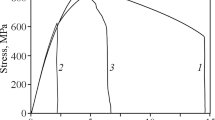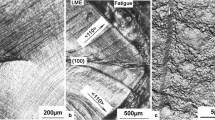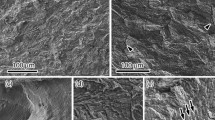Abstract
Metallographic, fractographic, and acoustic-emission studies have been carried out on the near-α commercial alloy, heat treated to produce the Widmanstätten structure and in some cases aged to precipitate α2. Both aged and unaged material underwent GHE in ∼ 10 kPa gaseous hydrogen, failure occurring along the α-β interface. Electron-diffraction studies established the presence of a layer of fee titanium hydride at the fracture surfaces, and acoustic-emission and fractographic observations indicated that propagation was discontinuous. The aged alloy underwent SSRHE in inert environments and SCC in 3 pct aqueous NaCl and, in contrast to GHE, failure occurred across the α-plates in both cases, producing indistinguishable cleavage-like fracture surfaces. Again, titanium hydride was detected at the fracture surfaces and, from acoustic-emission studies, crack propagation appeared to be discontinuous. Based on these observations, it is suggested that the three forms of failure occur by a common mechanism, namely by the repeated formation and rupture of the hydride phase.
Similar content being viewed by others
References
H. G. Nelson, D. P. Williams, and J. C. Stein:Metall. Trans., 1972, vol. 3, p. 469.
H. G. Nelson:Metall. Trans. A, 1976, vol. 7A, p. 621.
J. P. Blackledge:Metal Hydrides, p. 2, Academic Press, NY, 1968.
V. A. Livanov, B. A. Kolachev, and A. A. Buhanova:The Science, Technology and Application of Titanium, p. 561, Pergamon Press, 1970.
J. C. Scully:Stress-Corrosion Research, NATO ASI Series E, Appl. Sci-No. 30, p. 209, Sijthoff and Noordhoff, The Netherlands, 1979.
D. A. Meyn:Metall. Trans., 1972, vol. 3, p. 2302.
G. G. Libowitz:J. Nuc. Mat., 1960, vol. 2, p. 1.
W. M. Mueller: Ref. 3, p. 336.
G. H. Koch, A. J. Bursle, and E. N. Pugh:Metall. Trans. A, 1978, vol. 9A, p. 129.
M. J. Blackburn and J. C. Williams:Fundamental Aspects of Stress-Corrosion Cracking, p. 620, NACE, Houston, 1969.
D. A. Meyn and G. Sandoz:Trans. TMS-AIME, 1969, vol. 245, p. 1253.
N. E. Paton and R. A. Spurling:Metall. Trans. A, 1976, vol. 7A, p. 1769.
J. Katz and W. W. Gerberich:Int. J. of Fract. Mech., 1970, vol. 6, p. 219.
G. H. Koch, A. J. Bursle, and E. N. Pugh:Second International Congress on Hydrogen in Metals, 3D4, Pergamon, 1977.
J. L. Nelson and J. A. Beavers:Metall. Trans. A, 1979, vol. 10A, p. 658.
D. N. Fager and W. F. Spurr:Trans. ASM, 1968, vol. 61, p. 283.
D. G. Chakrapani and E. N. Pugh:Metall. Trans. A, 1975, vol. 6A, p. 1155.
J. A. Beavers and E. N. Pugh:Metall. Trans. A, 1980, vol. 11 A, p. 809.
K. A. Peterson, J. C. Schwanebeck, and W. W. Gerberich:Metall. Trans. A, 1978, vol. 9A, p. 1169.
G. H. Koch: Ph.D. Thesis, University of Illinois at UrbanaChampaign, 1976.
D. A. Meyn: Rept. NRL Prog., Sept. 1969, p. 34.
A. J. Bursle and E. N. Pugh:Mechanisms of Environment Sensitive Cracking of Materials, p. 471, The Metals Society, London, 1977.
A. J. Bursle and E. N. Pugh:Environment-Sensitive Fracture of Engineering Materials, p. 18, TMS-AIME, Warrendale, PA 1979.
J. J. DeLuccia: Naval Air Dev. Center Report No. 76207-30, June, 1976.
J. D. Boyd:Trans. ASM, 1969, vol. 62, p. 977.
A. R. Troiano:Trans. ASM, 1960, vol. 52, p. 54.
R. A. Orianai:Ber. Bunsenges. Phys. Chem., 1972, vol. 76, p. 848.
R. J. Wasilewski and G. L. Kehl:Metallurgia, 1958, vol. 50, p. 455.
A. Vassel:Environment-Sensitive Fracture of Engineering Materials, p. 277, TMS-AIME, Warrendale, PA, 1979.
W. H. Smyrl: Molten Salts, p. 282, The Electrochem. Soc, Inc., 1976.
Author information
Authors and Affiliations
Additional information
formerly with the Department of Metallurgy and Mining Engineering and Materials Research Laborary, University of Illinois, Urbana, Illinois.
Rights and permissions
About this article
Cite this article
Koch, G.H., Bursle, A.J., Liu, R. et al. A comparison of gaseous hydrogen embrittlement, slow-strain-rate hydrogen embrittlement, and stress-corrosion cracking InTi-8Ai-1Mo-1V. Metall Trans A 12, 1833–1843 (1981). https://doi.org/10.1007/BF02643767
Received:
Issue Date:
DOI: https://doi.org/10.1007/BF02643767




